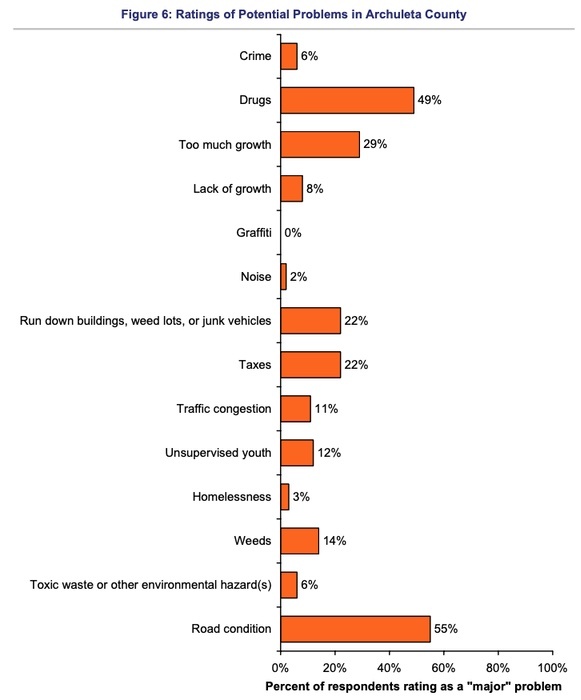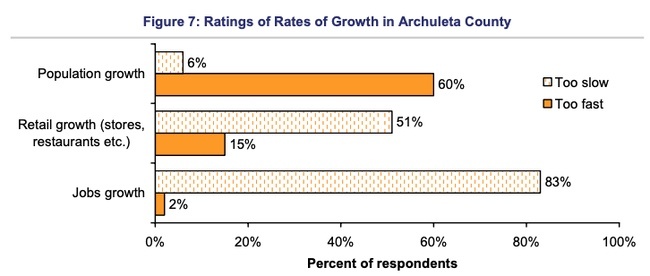We might have a housing crisis, here in Archuleta County. I think no one knows for sure. The most recent data dates from 2005. That housing crisis might be part of a larger economic crisis, that includes a lack of potential employees to operate the businesses that have located here over the past couple of decades.
Where do we stand at the moment? How did we get here?
Back in 2009, the Archuleta County real estate and construction industries had seriously stagnated following twenty years of remarkable activity. The planners and leaders at both local governments — the Town of Pagosa Springs and Archuleta County — were using the slowdown in population growth and real estate development to try and put some new policies in place — new policies that probably would have done us more good if they’d been put in place twenty years earlier.
It was time to catch our breath, and take a look at where we’d come, and at where we might want to head.
At a meeting of the Archuleta County Planning Commission — a group of volunteers who had been working overtime for nearly a year on long-range planning issues — the County’s then-associate planner Cindy Schultz gave a report that included the following points to contemplate:
The Planning Commission and the community need to answer two critical questions, initially:
Does Archuleta County want additional growth?
If so, where are the most sensible, logical locations for that growth?
And if so, what type of growth should be encouraged, that follows the spirit of the Regs and the policies of the [Community] Plan?
We might note that Ms. Schultz was proposing that we “need to answer two critical questions.”
But she actually posed three questions, not two.
Maybe no one really paid any attention to the first question — “Does Archuleta County want additional growth” — because it was purely rhetorical. Maybe it didn’t matter if we wanted “additional growth” because our community leaders were assuming we were going to get it anyway, whether we wanted it or not? Maybe “additional growth” was, after all, the Ultimate Purpose of Pagosa Springs’ existence?
Nevertheless, I’d like us to look at that first question anyway for a moment — even if the community’s planners and leaders acted like it didn’t need to be answered, back in 2009.
”Does Archuleta County want additional growth?”
The answer to that question is actually quite simple, but it depends upon your definition of “Archuleta County.” If, by “Archuleta County” you mean “the people who live in Archuleta County,” the answer has generally been: “No.”
To verify that, we need look no further than the 2007 Citizens Survey, conducted on behalf of the County.
Click here to 2007-Archuleta-Citizen-Surveydownload the complete 51 page survey.
The survey team sent out 1,200 surveys to a random sampling of County residents, supposedly representing all walks of life, and got responses from about 25 percent of those contacted. Here is the chart from page 14:

In 2007, the three biggest problems facing our community, these citizens reported, were, in this order:
Road Conditions (55%)
Drugs (49%)
Too much growth (29%)
As a community problem, “Drugs” beat out “Too much growth” by a wide margin. But “Too much growth” easily beat “Lack of growth” — by nearly a 4-to-1 margin: 29% thought “Too much growth” was a major problem; only 8% thought “Lack of growth” was a problem.
Turn to the next page, page 15, and the results are perhaps even more dramatic:

What did our neighbors think of Archuleta County’s growth in 2007?
60 percent thought it was growing too fast. 6 percent thought was growing too slowly. That’s a 10-to-1 ratio.
Ms. Schultz’ question was “Does Archuleta County want additional growth?” Answer: No, the people of Archuleta County did not want additional growth — we didn’t even want the growth we already had.
Turn to page 35 of the same survey. “How do you rate Archuleta County as a place to live?” 81 percent of the respondents answered either “Excellent” or “Good.”

In 2007, more than 8 out of 10 people thought our community — as it currently existed — was a ‘good.’ or even ‘excellent,’ place to live. Only 1 out of 4 rated it ‘good’ or ‘excellent’ as a place to work, at the peak of its economic growth in 2007.
The Archuleta County Community Plan was created during the year 2000, with the input of over nine hundred residents who attended numerous meetings. You can click here to download the complete 46-page Plan.
That Community Plan begins with a Vision Statement:
Archuleta County should retain its outstanding scenic and natural qualities while providing quality employment, housing, education, and recreation to its residents. Tourism, recreation, and agriculture will remain major segments of the economy, but attempts will be made to diversify and encourage other types of economic development. The majority of youth should be able to have a career and eventually raise a family without being forced to leave. A healthy and vibrant community will continue to evolve and the rural character and small town atmosphere will be preserved.
That’s a pretty visionary vision, no doubt about it. But then, vision statements are supposed to be visionary.
How were we doing in attaining such a community in 2007? Pretty well on the “scenic” part, and the recreation part was not faring too poorly.
“Quality employment, housing, education?” Maybe those components needed more work?
Tourism has indeed remained the County’s main industry — but we have diversified the economy hardly at all. When I moved to Pagosa Springs, there were no web designers living here, for example — now we have a handful. Back then, we didn’t have a shop specializing in oil changes; now we have one. Back then, we didn’t have any fast food restaurants; now we have a handfull.
Little by little, we seem to be diversifying. But few of the “diverse” businesses are the type that bring money into the local economy; they mainly recycle the money that’s already here. The only significant “new” money flowing into the Pagosa Springs economy, other than from additional tourists, has been from the pension checks and investment income coming from the second-home owners and retirees who made up the majority of the “growth” between 1990 and 2007.
“The majority of youth should be able to have a career and eventually raise a family without being forced to leave,” says the Community Plan. We have definitely lost ground on that one; growth has made housing much less affordable without significantly increasing wages.
“A healthy and vibrant community will continue to evolve and the rural character and small town atmosphere will be preserved.” Well, that’s a judgment call. I’d say, generally speaking, growth did very little to help with that part of our future vision.
As I attend government and community meetings and work sessions in 2015, the main worry I hear expressed relates to jobs.
Not a worry that we have a lack of jobs. But rather, that we have a lack of willing workers to the fill existing jobs.
“Quality employment” never quite arrived, despite massive community growth. “Housing” for our working class never quite got built. “Education” did not become one of the community’s key features.
Maybe growth didn’t really help… after all?
